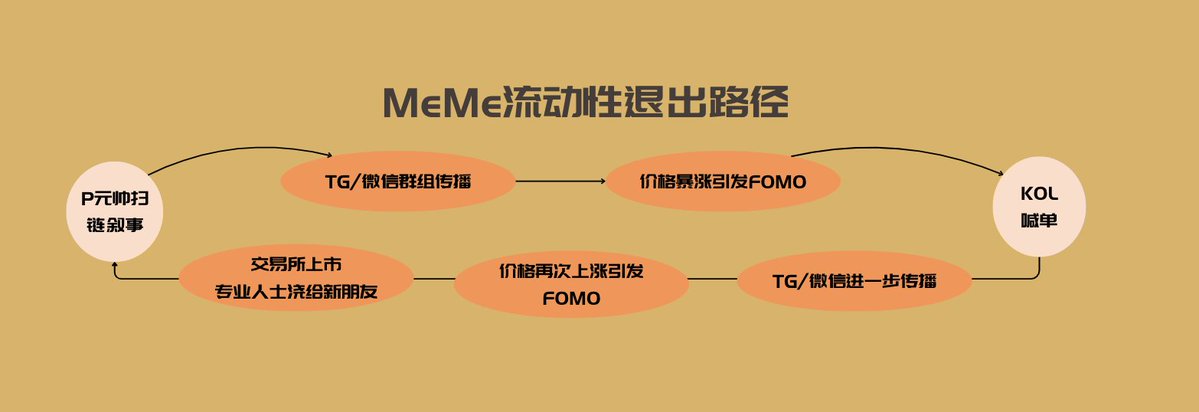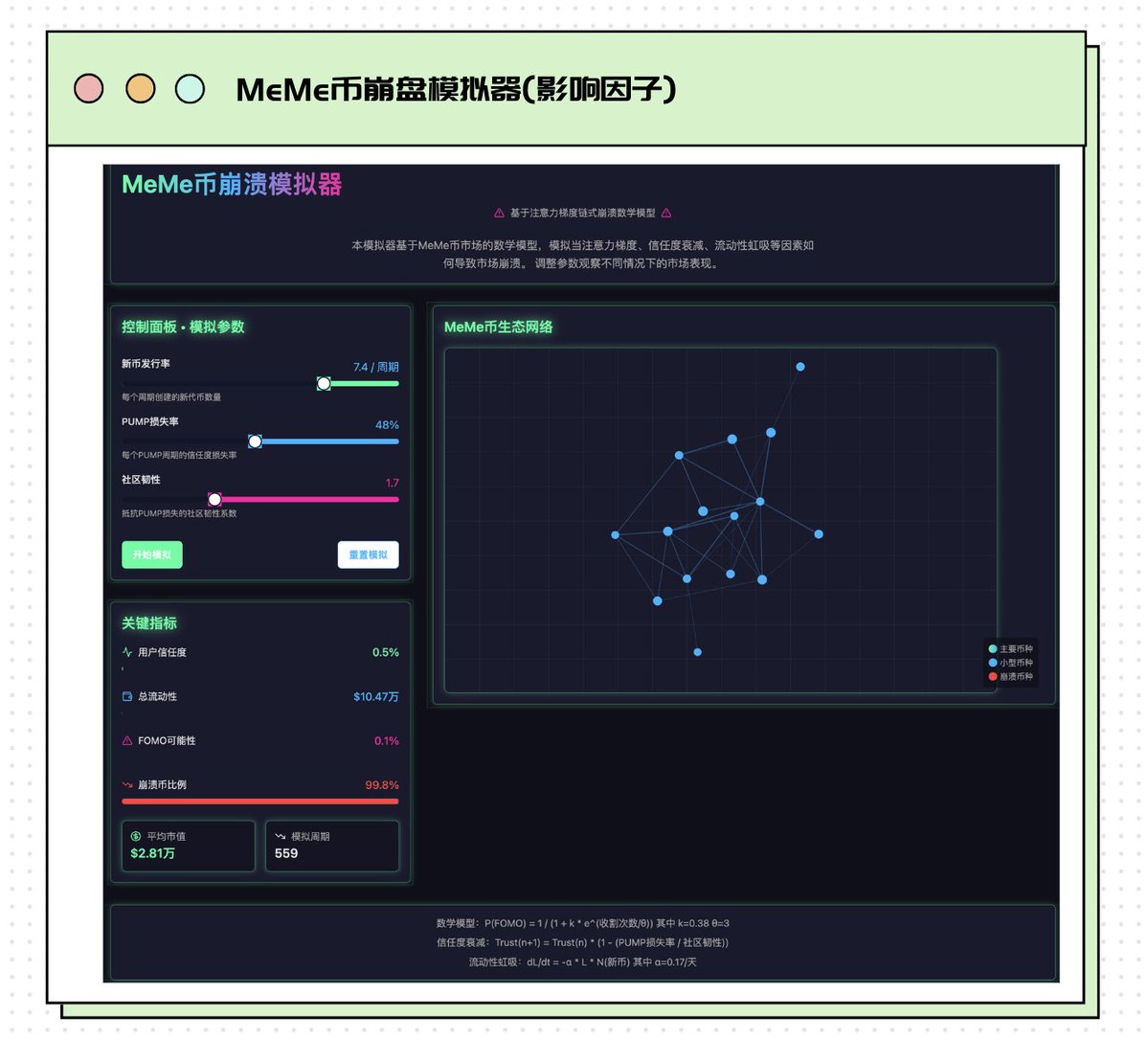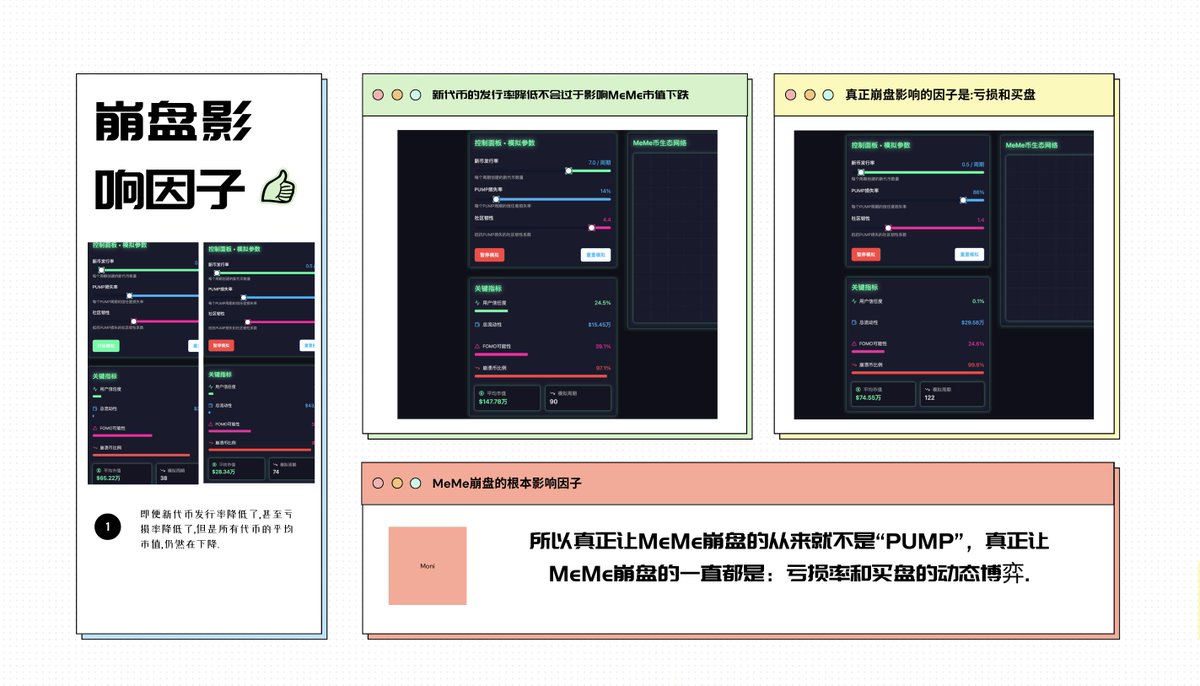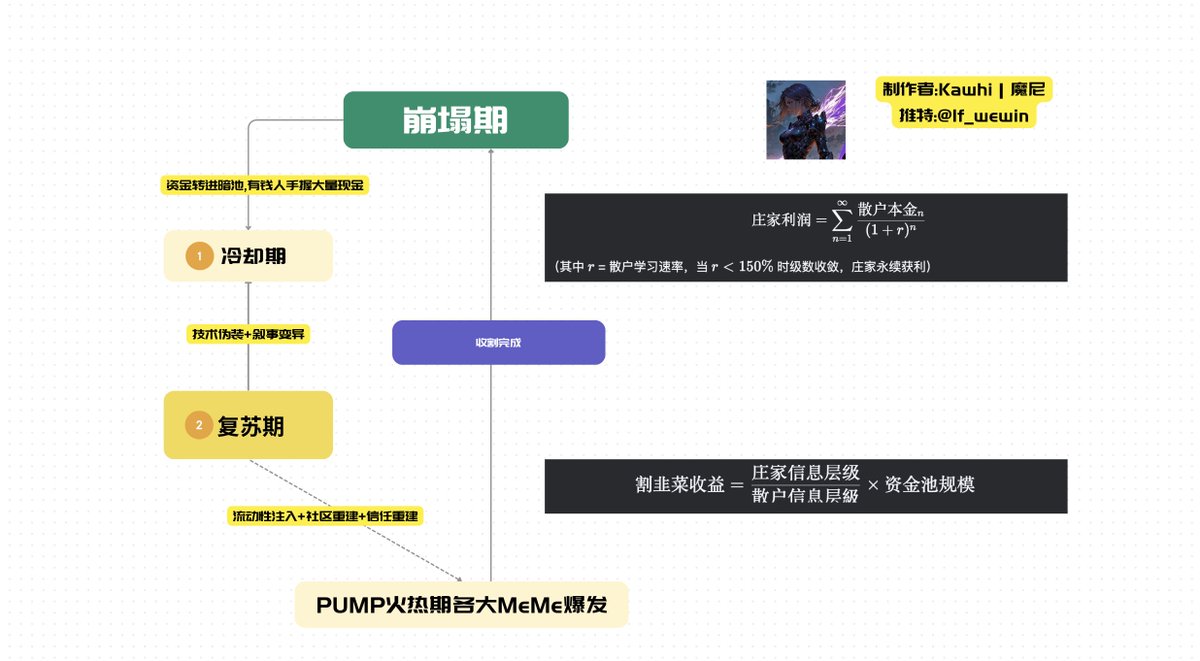Looking back, many people think they made money through hard work, but essentially they caught the wave of the times.
Today, the environment has changed. It's not that "you're not working hard enough," but rather "the old map is no longer valid."
Growth starts with refreshing your understanding.
I created a MeMe crash simulator using the logic of physical kinematics, intuitively telling you why after Trump, we haven't seen MeMes like WIF, Popcat, MooDeng, chiilguy, bome anymore. Before diving into the main content, let's start with an introduction: Why haven't there been any big MeMes? ● Besides the reasons that have been talked to death: SOL bonuses expired, the macro market environment is bad, and poor liquidity in the bear market. ● Another reason is, as DNF said: Ai coins, CTO coins, celebrity coins, meme coins, artist coins, Musk series derivative coins, Cz/heyi derivative coins, Alt platform coins. We've almost played through all types of tokens... /// The cycle is accelerating, and we have nothing left to play with... We used to often talk about the standard features of a golden dog: ① Grand narrative, ② Easy to understand, ③ Mass dissemination. But this "golden dog standard" now faces a problem— We are facing an increase in market information entropy forcing a reallocation of weights, and the narrative and dissemination path of traditional MeMes has collapsed. In the past, our view of MeMes was always "fun, viral spread," and the market's choice of MeME was always based on the "simplest narrative" as the only query, using short-term emotional fluctuations as the key-value. Attention weight = FOMO emotion intensity × social media dissemination speed. The dissemination path of MeMe has always been this exploration— But, here's the problem—actually, MeMe coins face the same problem as altcoins, there are really too many coins with similar narratives/technologies... And the emergence of PUMP has caused our market information entropy to surge. If you've been active for two cycles, you'll find that not only altcoins, but actually MeMe coins with similar narratives have more tokens than the last cycle... It is precisely because of the wealth effect brought by PUMP that everyone, after missing the first dragon, rushes to find the second dragon, the third dragon, looking for the next 10x, 100x opportunity, and the final result is a chain collapse of attention gradient. After all, the linear narrative dissemination that traditional MeMe relies on has always been— Œ /// Social media → Exchange listing → FOMO buying → Price surge This process is somewhat like the gradient descent optimization of a neural network, amplifying signals layer by layer to achieve price "training," but this "linear narrative dissemination" is fragile because this path is essentially a unidirectional information potential difference-driven system. If viewed from a dynamic model, it can be compared to the voltage gradient in a circuit: ΔV=V social media−V FOMO buying Each dissemination efficiency depends on the "conductivity" of each link, but the instability of "conductivity" itself will eventually bring breakpoints to the system. 1️⃣ Information potential decay (social media layer): **KOL shouting orders are no longer believed. 2️⃣ Conduction layer blockage (exchange layer): Teacher Cz understands the logic of meme information difference, and the universe does not make the last stick for MeMe coins. 3️⃣ Terminal load overload (FOMO buying layer): Retail investors' resistance evolution: Generally, after experiencing 3 harvests, the probability of FOMO decreases by 50%... So if viewed from a mathematical model— ● Each PUMP (god coin) collapse leads to a decline in community trust: Trust n+1=Trust n⋅(1−PUMP loss rate community resilience) Trust n+1=Trust n⋅(1−community resilience PUMP loss rate) Typical MeMe coin community trust returns to zero after 3 PUMP cycles. 4️⃣ Liquidity siphon effect dtdL=−α⋅L⋅N new coins α=0.17/day New projects drain the liquidity of old projects: dLdt=−α⋅L⋅N new coins α=0.17/day Œ /// So whether everyone chooses to believe it or not, the "meme" hell difficulty we are facing now is because— Retail investors have evolved, the dealers have become ruthless, the transactions do not buy, and the "conductivity" of each large-scale dissemination path of past MeMes has problems. ——Narrative expectations and price feedback are decoupled → Whether it's you and me as retail investors, or dealers, or exchanges, they are all voting with their feet to accelerate withdrawal... If you find the above model interesting, you can go " You can try to control: 1️⃣ New coin issuance rate, 2️⃣ PUMP loss rate, 3️⃣ Community resilience What kind of path do these three need to take to achieve average market value growth of tokens in a simulated cycle environment, and what kind of balance between the three will lead to the "average token market value" continuously collapsing. Of course, the model has a flaw because "MeMe itself is also a cyclical emotional asset" it cannot consider larger cycle changes, and MeMe itself is a dynamic game, the model cannot accurately judge the concrete, that is, the "collapse" of a single MeMe. Just for reference— But if you use the above simulator and play with the "MeMe crash simulator," you will get a very obvious result, that is—◊◊◊ It seems that the more new tokens, the higher the loss rate, the lower the average market value, and the higher the proportion of collapse.? So in the past few months, everyone has been scolding "PUMP" and saying "MeMe collapsed" because of the birth of PUMP— Because the emergence of "PUMP" gave everyone too many choices, so consensus did not gather, causing "MeMe collapse"? Œ /// But is this really the case? No. If you are in the "MeMe crash model," even if we pull the "new coin issuance rate" to the lowest and write the loss rate as "80%," that is, 80% of people lose money, and the community resilience is given as 4.5 (very high), you will find a conclusion: —— Even if the "number of token issuance cycles" decreases, as the simulation cycle progresses, the average market value of tokens still declines, which is what we commonly say: the ceiling of MeMe is getting lower and lower. ● So what really causes MeMe to collapse has never been "PUMP," what has always caused MeMe to collapse is: loss rate and buying imbalance. The speed of token issuance has never been a decisive factor, MeMe itself is actually a very "closed" market—just like many old players, they themselves play small in the MeMe market, they look down on the "casino" logic, let alone whether Teacher cz likes to play big MeMe. Without PUMP, many MeMes do not have liquidity, and without liquidity, there is no "community resilience (buying) impact, and the final outcome is still—collapse. To some extent, the essence of the PUMP mechanism is to forcibly inject negative entropy flow into a closed system (single MeMe ecosystem), creating an orderly structure (price surge) in the short term—only then can the liquidity assets complete the exit. This is also what the owner @thecryptoskanda said: "The market will always reward"—teams that can continuously create assets and markets with high volatility and high liquidity at the lowest cost. This is also why the owner has always emphasized the greatness of "PUMP," the MeMe market itself is closed—MeMe has always been a very pure capital disk and Ponzi dynamics • The system energy has always relied on internal circulation: Œ /// New investor funds → Push up prices → Attract more funds The emergence of PUMP attracted countless "new funds and newcomers" to enter the market, and these influxes like me completed the internal circulation flow. To some extent, the emergence of PUMP or the PUMP mechanism is an attempt to create a perpetual motion machine in a closed box, but the problem is that forcibly creating a local low entropy state in a closed system inherently violates the iron law of "global entropy not decreasing," so collapse is inevitable, and this is visible. ▽▽▽ /// But this is not caused by PUMP, but by the iron law of physics. However, just like the logic of "universe contraction," it is precisely because of the collapse that a new "big bang" cycle will be generated. The beginning of this cycle will be very interesting. It seems convoluted, but it's actually not complicated at all, because it is a perpetual motion machine cycle of "harvest-repair-reharvest." Œ /// Let's just say: if you want to cut leeks more elegantly— After the liquidity collapse, you and I, as leeks, are actually in a "wait-and-see state" because of dissatisfaction with the current emotions, So a new narrative is needed, and a new "narrative" also requires the so-called "new technical disguise and narrative mutation"... We need to believe that the emergence of a new "recovery period" will start buying... What's interesting here is that according to the Ebbinghaus curve: Design the cooling period length T=ln(maximum loss memory strength)/λln where: λ = New narrative bombing intensity (usually set to make T≈6−8 months) To some extent, everyone can also understand that "leeks" basically only need "6-8" months to "grow back and be cut," of course, this is not certain, because it is also related to the "damage degree" of old leeks and the proportion of new leeks, but the logic remains unchanged... When AI+MeMe begins to officially recover, and one day in the future becomes "technology is a street rat," we will once again embrace the narrative-driven MeMe of PUMP. This is very similar to the high valuation VC coins that everyone shouts about bringing narrative MeMe dividends, so many things seem to have changed, but they haven't. Œ /// The essence of the dealer's super cycle harvesting technique is the time arbitrage game of funds. The only change is, if you want to find the so-called "technical disguise" and "narrative mutation," you need to learn not how the "dealer" manipulates, because on-chain data is too easy to deceive people, the difficulty is increasing, and ordinary people basically won't analyze on-chain, But you can't not dance with the dealer, after all, in this process, we either become the sickle or become fertilizer. So this is also why I have always admired Sister Hui @0xmagnolia, because Sister Hui is always looking for new alphas, from traditional meme to narrative mutation meme to technical disguise "MCP" meMe, Sister Hui's judgment on "Alfar" and this is truly endless. The dealer is progressing, continuously evolving harvesting technology, We can only avoid becoming the next batch of leeks by turning ourselves into an open system (continuously learning real technology), in this never-ending entropy increase war: "escape speed must exceed entropy increase speed," we can survive in the dark forest, We need to learn from "Zhang Beihai"— What we need to do is: "Natural selection, move forward four" Do more positive EV things, less Twitter, look at Twitter projects and memes. What is positive EV? Brother Hua @off_thetarget recently said it very clearly, become an insider, learn upwards, get close to power, become power, learn a lot. In fact, this is also PUMP, being an influential person is not enough, you actually need to be a person like PUMO, to become a person who creates liquidity value assets, That is, you are wealth itself. I will work hard, and I hope you who read this article can also work hard. Let's encourage each other.




17.4K
25
The content on this page is provided by third parties. Unless otherwise stated, OKX is not the author of the cited article(s) and does not claim any copyright in the materials. The content is provided for informational purposes only and does not represent the views of OKX. It is not intended to be an endorsement of any kind and should not be considered investment advice or a solicitation to buy or sell digital assets. To the extent generative AI is utilized to provide summaries or other information, such AI generated content may be inaccurate or inconsistent. Please read the linked article for more details and information. OKX is not responsible for content hosted on third party sites. Digital asset holdings, including stablecoins and NFTs, involve a high degree of risk and can fluctuate greatly. You should carefully consider whether trading or holding digital assets is suitable for you in light of your financial condition.


